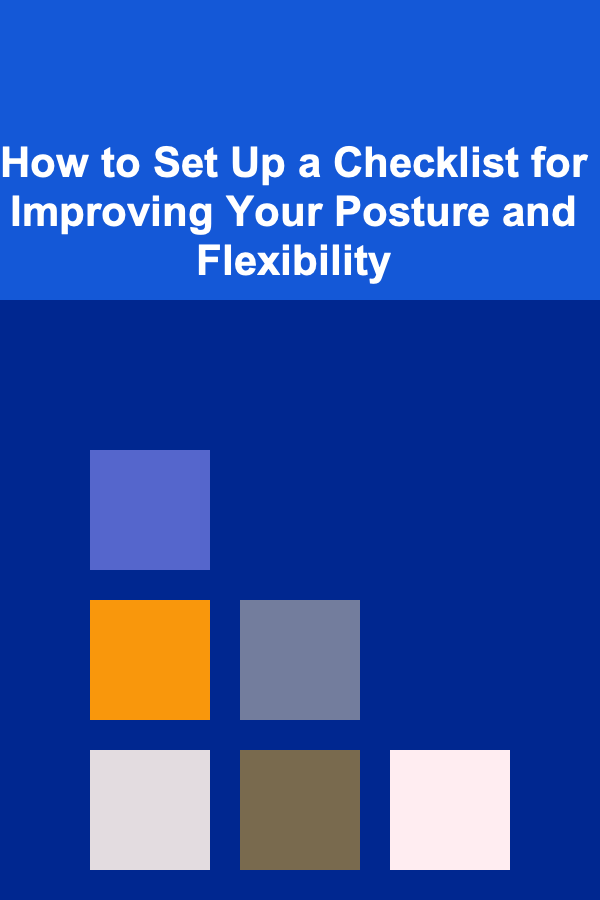
How to Set Up a Checklist for Improving Your Posture and Flexibility
ebook include PDF & Audio bundle (Micro Guide)
$12.99$5.99
Limited Time Offer! Order within the next:

Posture and flexibility are crucial components of physical health that often go overlooked. Poor posture can lead to chronic pain, tension, and discomfort, while a lack of flexibility can restrict movement and increase the risk of injury. Improving both can help you feel more energetic, reduce the risk of pain, and increase overall physical well-being. Setting up a checklist is an actionable way to stay on track and ensure continuous progress.
In this guide, we'll walk you through how to set up a checklist for improving your posture and flexibility, with actionable steps to incorporate into your daily routine.
Understand the Importance of Posture and Flexibility
Before diving into the specifics of your checklist, it's essential to understand why improving posture and flexibility matters:
1.1 Posture
Good posture is the alignment of your body that puts the least strain on muscles, ligaments, and joints. When you maintain proper posture, it helps to:
- Prevent back, neck, and shoulder pain.
- Reduce the risk of long-term musculoskeletal issues.
- Enhance breathing by allowing your lungs to expand properly.
- Improve digestion by avoiding compression of the internal organs.
- Boost your confidence and energy levels.
1.2 Flexibility
Flexibility refers to the range of motion in your joints and muscles. Regularly stretching and practicing flexibility exercises can:
- Improve mobility and functional movement.
- Reduce muscle stiffness and tightness.
- Promote better posture.
- Lower the risk of injuries in daily activities and exercise.
- Enhance circulation and muscle recovery.
Create Your Posture and Flexibility Checklist
Creating a checklist is a powerful tool to track progress and stay consistent with your posture and flexibility improvement goals. Here's a structured checklist you can follow.
2.1 Posture Checklist
Maintaining good posture throughout the day requires mindful effort, especially for people who sit for long periods or work at desks. Use this checklist to ensure you're adopting good posture habits in different scenarios.
Desk and Computer Posture
- Feet flat on the floor: Keep your feet flat on the ground or on a footrest to maintain stability.
- Knees at a 90-degree angle: Your knees should be in line with your hips.
- Back support: Use a chair that provides lumbar support to maintain the natural curve of your spine.
- Shoulders relaxed: Avoid slouching or hunching your shoulders. Your shoulders should be relaxed and not raised.
- Monitor at eye level: Position your computer screen at eye level to prevent neck strain.
- Wrist alignment: When typing, keep your wrists in a neutral position to avoid strain on your wrists and forearms.
- Breaks and movement: Every 30--60 minutes, take a break to stand, stretch, or walk around to avoid stiffness.
Standing Posture
- Align your head, shoulders, and hips: Your ears should be aligned with your shoulders, and your shoulders should be aligned with your hips. Avoid leaning forward or backward.
- Distribute weight evenly: Avoid shifting weight onto one leg. Distribute your body weight evenly across both feet.
- Engage your core: Activate your abdominal muscles to support your spine and prevent overextension.
- Relax your hands: Keep your hands at your sides or resting naturally to avoid unnecessary tension in the shoulders.
Posture While Sitting
- Back straight and supported: Sit all the way back in your chair with your lower back supported.
- Feet flat on the ground: Your feet should rest flat on the floor or on a footrest.
- Avoid crossing your legs: Crossing your legs can cause misalignment in the pelvis and spine. Keep both feet on the ground.
2.2 Flexibility Checklist
Stretching and mobility exercises help improve flexibility, which can enhance posture and prevent injuries. Incorporate these stretches into your daily routine to maintain flexibility.
Morning Stretches (Wake Up Your Body)
- Neck stretches: Gently tilt your head from side to side and hold for 15--30 seconds on each side.
- Shoulder rolls: Roll your shoulders forward and backward to release tension.
- Cat-Cow stretch: On all fours, alternate between arching your back (cow) and rounding it (cat) to mobilize the spine and stretch the torso.
- Hamstring stretch: Sit on the floor with one leg extended and gently reach for your toes. Hold for 15--30 seconds per side.
- Hip flexor stretch: Step one foot forward into a lunge, keeping your back leg straight to stretch the hip flexors.
Midday Mobility (Combat Tightness)
- Standing forward fold: Stand with your feet hip-width apart, bend at the hips, and reach toward the floor. This stretches the hamstrings, lower back, and calves.
- Thoracic spine rotation: Sit or stand with your arms extended in front of you and gently rotate your upper body to one side, keeping your lower body stable. This helps improve spinal mobility.
- Lunge with a twist: Step one foot forward into a lunge and twist your torso toward the forward leg. This stretches the hip flexors and engages the core.
- Seated spinal twist: Sit cross-legged on the floor, place your right hand behind you, and gently twist your torso to the right. Repeat on the other side.
Evening Stretches (Wind Down and Relax)
- Child's pose: Kneel on the floor, sit back on your heels, and extend your arms forward to stretch the back and hips.
- Pigeon pose: From a tabletop position, bring one knee forward, extending the opposite leg straight behind you. This stretches the hips and glutes.
- Seated forward fold: Sit with your legs extended straight, then hinge at your hips and reach for your toes. This stretches the hamstrings and lower back.
- Quadriceps stretch: Stand on one leg and bend the other knee to bring your heel toward your glutes. Hold your ankle and gently pull to stretch the quads.
2.3 Posture and Flexibility Maintenance
Maintaining good posture and flexibility requires continuous effort. Here's how to keep yourself consistent with your goals:
- Track your progress: Keep a log of your daily posture habits and flexibility stretches. Note any improvements or areas that need more attention.
- Set reminders: Use phone or computer reminders to check your posture throughout the day. Schedule your stretching sessions to stay consistent.
- Monitor your posture regularly: Perform a "posture check" at various intervals during the day, especially when transitioning between activities (e.g., sitting, standing, walking).
- Gradual progress: Flexibility improves gradually, so don't expect immediate changes. Set realistic, small goals and celebrate milestones.
Tips for Success
3.1 Incorporate Movement into Daily Life
Sitting for extended periods can contribute to poor posture and tight muscles. To counteract this, incorporate movement into your day:
- Walk or stretch during breaks at work.
- Take the stairs instead of the elevator.
- Do quick mobility exercises in the morning and evening.
3.2 Practice Mindfulness
Being mindful of your posture throughout the day is crucial. Whether you're sitting at your desk, walking, or standing, take a moment to check in with your body and adjust as needed.
3.3 Consistency is Key
Just like any other health goal, improving posture and flexibility requires consistency. Stick to your checklist and gradually incorporate these habits into your routine until they become second nature.
3.4 Seek Professional Guidance
If you're unsure how to perform stretches correctly or if you have specific concerns about posture, consider consulting a physical therapist or fitness professional. They can help you address any issues and ensure you're performing exercises safely.
Conclusion
Improving posture and flexibility is an ongoing process, but by setting up a checklist and sticking to it, you can achieve significant improvements in your physical health. The actionable steps outlined in this guide will help you develop better posture habits, enhance flexibility, and ultimately lead to a more comfortable and active lifestyle. Stay consistent, be patient with your progress, and enjoy the benefits of a healthier, more flexible body.

Beyond Borders: International Expansion Strategies for the Aspiring Business Development Manager
Read More
How to Create a Family Gratitude Journal Together
Read More
How to Make Your Home Cozy for Senior Pets
Read More
How to Save Space in a Small Dining Area with Efficient Layouts
Read More
How to Teach Kids About Money Management for Their Future
Read More
How to Use Note-Taking Apps for Effective Information Management
Read MoreOther Products

Beyond Borders: International Expansion Strategies for the Aspiring Business Development Manager
Read More
How to Create a Family Gratitude Journal Together
Read More
How to Make Your Home Cozy for Senior Pets
Read More
How to Save Space in a Small Dining Area with Efficient Layouts
Read More
How to Teach Kids About Money Management for Their Future
Read More